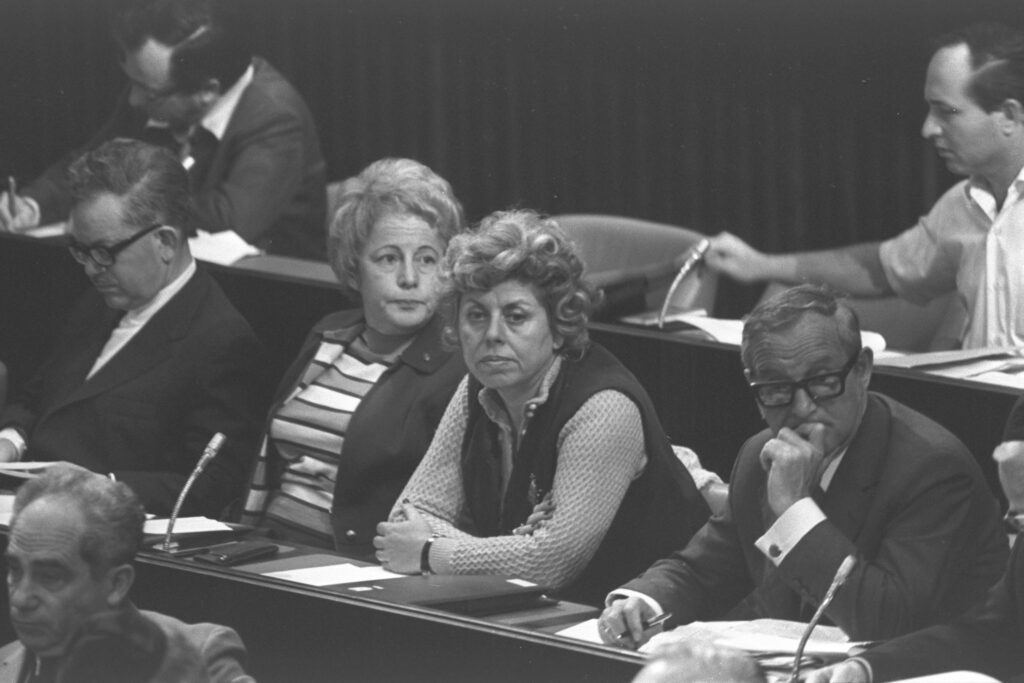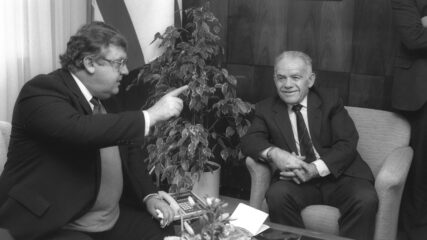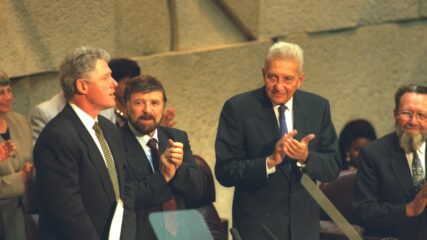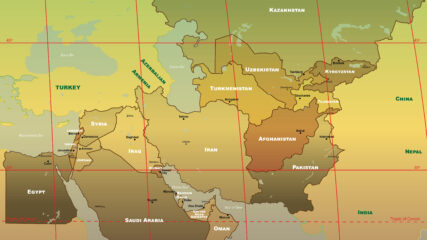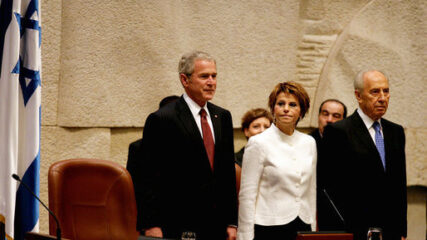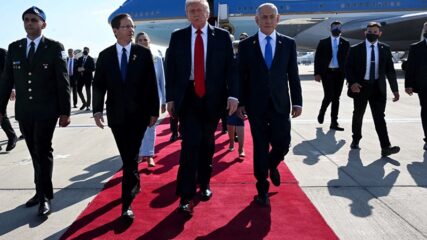When Prime Minister Ehud Olmert resigned in 2008 amid allegations of bribery, Israel came within reach of a milestone in gender equality — one that was a credit to the Jewish state as much as the corruption scandal was an embarrassment to it. The stars of Israeli leadership aligned to form a constellation of female power: Dorit Beinisch as president of the Supreme Court, Dalia Itzik as speaker of the Knesset, and Tzipi Livni as head of Kadima, the largest party in the Knesset.
If the Israeli system were the same as that of Britain and Canada, Olmert’s resignation would have elevated Livni to the premiership, and Israel would have become the second country, after New Zealand, where women presided over all three branches of government. But in the Jewish state, as in Italian and Japanese democracy, the resignation of the prime minister calls not merely for replacing the head of the government, but for reconstituting the entire Cabinet. In the negotiations with other political parties to form a new government, Livni failed to preserve, let alone expand, Olmert’s coalition.
Within sight but ultimately out of reach, the 2008 Israeli “breakthrough that wasn’t” in gender equality was remarkable nonetheless, even if more symbolic than substantive. It might also be said that it honored the spirit of Montesquieu, who conceived the separation of powers and the three-branch division of government: The 18th-century French philosopher was far ahead of his time in women’s and Jewish rights. Besides, if Israel’s close call was remarkable for a Western democracy, it was all the more so in a region consistently ranked among the world’s least hospitable to women. Montesquieu described the region as a land in which “power over women is purely tyrannical.”
Zionism and the Yishuv
Long before Israel nearly took second place to New Zealand in humanity’s race — or crawl — toward gender equality, the Zionist movement was runner-up to New Zealand another time. When the World Zionist Organization granted women the right to vote for and serve as delegates during the Second Zionist Congress in 1898, only one country had enfranchised women: New Zealand.
Zionism was indeed progressive where women’s rights were concerned. In Zionist writings and iconography, for instance, the figure of the robust, unbowed halutza (the female pioneer) was lionized, her depiction challenging gender norms by assigning her work not traditionally associated with women, such as construction, farming and, later, guard duty.
This is not to suggest that women had it easy or were given the respect accorded to men, even if they performed “men’s labor.” On the contrary, if, as the composer Gustav Mahler remarked, “A Jew is like a swimmer with a short arm: He has to swim twice as hard to reach the shore,” a Jewish woman had to swim thrice as hard. Yet women distinguished themselves in nearly every field of endeavor in pre-state Israel, their amphibious landfall no mere act of survival, but rather a swimmer’s feat.
So numerous and varied were their contributions that any noncomprehensive catalog of the outstanding women of the Yishuv must be selective and therefore deficient. Incomplete though it is, the following list is instructive. Note the diversity of the fields in which these women excelled (from medicine to espionage, architecture to agriculture) and of the women themselves (atheist and observant, German and Polish, Egyptian and Yemeni):
- Poetry — Rachel Bluwstein, Esther Raab, Yocheved Bat-Miriam and Leah Goldberg.
- Fiction — Devorah Baron and Anda Pinkerfeld Amir.
- Journalism — Bracha Habas and Mazal Mosseri.
- Theater — Hanna Rovina (“First Lady of Hebrew Theater”) and Esther Gamlielit.
- Visual arts — Tsiona Tagger and Chana Orloff.
- Architecture — Genia Averbuch and Lotte Cohn.
- Medicine — Sonia Belkind and Helena Kagan.
- Espionage — Sarah Aaronsohn and Ada Sereni.
- Education — Shoshana Persitz and Hemda Ben-Yehuda.
- Defense — Manya Shochat and Tzippora Zaid.
- Agrarian organizing — Rachel Yanait Ben-Zvi and Hannah Maisel-Shohat.
- Political and institutional leadership — Golda Meir, Ada Maimon, Henrietta Szold and Rachel Katznelson-Shazar.
- Music — Shoshana Damari, Bracha Tzfira and Verdina Shlonsky.
- Dance — Sarah Levy-Tanai and Rivka Sturman.
- Women’s advocacy — Nehamah Pukhachewsky and Tzina Rabinowitz.
- Land acquisition — Olga Hankin.
Just as recognition for women, however formidable their talents, was hard won, so too was the establishment of women’s rights and women’s welfare organizations. While the stirrings of women’s advocacy in the Yishuv date to the last years of Ottoman rule, when women’s training farms and collectives sprouted, systematic women’s organizational activity began in earnest during the first years of British rule. The Union of Hebrew Women for Equal Rights in Eretz Israel, focused on women’s suffrage and equal rights, was founded in 1919. The following year, the Working Women’s Council was established as the women’s branch of the Histadrut trade union. The WWC participated in the campaign to eradicate malaria and promoted sanitation, vaccinations and public health awareness. Also founded in 1920 was the Hebrew Women’s Federation, which rendered welfare services and aid to the women and children of the Yishuv.
Around the same time, two influential Zionist women’s organizations were established abroad that concentrated their activities in the Yishuv.
Hadassah, the Women’s Zionist Organization of America, was founded in 1912. Hadassah established clinics, nursing schools, dispensaries and hospitals in the Yishuv, but the crown jewel of its many contributions was Hadassah Hospital on Mount Scopus, the finest hospital in the Levant.
The Women’s International Zionist Organization, a social welfare organization that provided prenatal care, vocational training and other services to women, was founded in London in 1920.
Two decades after women secured the right to vote and to run in elections for the World Zionist Congress, another Jewish representative body was founded, Mandatory Palestine’s Jewish Assembly of Representatives (Asefat Nivcharim), for which women were similarly enfranchised. In 1920, the year the 19th Amendment to the U.S. Constitution granted women’s suffrage, the Assembly of Representatives held the first of four elections (1920, 1925, 1931, 1944) in which women both voted and were elected.
If the Asefat Nivcharim was the quasi-parliament, its executive council, the Vaad Leumi, was the Jewish community’s quasi-government or Cabinet. On each of the four councils elected by the Asefat Nivcharim, women held appointments.
Political representation was just one of many domains in which women made their mark in the Yishuv. Women particularly distinguished themselves in Hebrew letters. In the 1920s, a constellation of luminaries — Rachel Bluwstein, Yocheved Bat-Miriam, Esther Raab, Leah Goldberg, Elisheva Bikhovsky — shone in the Hebrew firmament, enriching the canon with their poetry.
Women also practiced occupations as managers and owners, often in fields not typically associated with their half of the species. As Dafna Izraeli notes, the 1920s saw women’s tobacco collectives, floor tiling communes and two women’s construction groups.
Female participation in the labor force grew throughout the British Mandate. Women primarily worked in the service sector — e.g., nursing, education and sales — but they also were employed in agriculture — dairy work on kibbutzim and citrus picking, sorting and packing — and in light manufacturing — handicrafts, textiles, apparel. The eve of Israeli statehood found women making up more than a quarter of the Yishuv’s labor force, a proportion similar to contemporary Western countries and a marked contrast to the Arab sector, where the female share of the labor force was less than 1%.
Statehood
The State of Israel is one of the few countries that have enshrined gender equality since their inception. The Israeli Declaration of Independence committed the Jewish state to ensuring “complete equality of social and political rights to all its inhabitants irrespective of religion, race or sex.” As if dramatizing both the promise itself and the divide between an assurance on paper and a reality on the ground, the Declaration of Independence includes women among its 37 signers, but just two: Golda Meir and Rachel Cohen-Kagan, who served on the provisional pre-state People’s Council.
In other respects, though, the on-the-ground reality represented the spirit of the Declaration more faithfully —nowhere more so than in the War of Independence. Israeli women were players in that most symbolically masculine human institution, called “a man’s game” by Virginia Woolf: war. Jewish women served not only as combat medics and signal corps operators, but also as squad leaders and riflewomen. They even fought in the elite Palmach strike force.
Contrast the combat service of Israeli women with the condition of women in the Arab combatant states. In half the countries engaged against Israel (North Yemen, Saudi Arabia and, to a lesser extent, Jordan), women were effectively marital chattel — i.e., spousal property.
When the inaugural Knesset was gaveled into session in 1949after the war, more cracks surfaced in Israel’s glass ceiling. Eleven women were elected to the first parliament, including Cohen-Kagan, whose WIZO fielded its own list of candidates. Meir, meanwhile, was part of the first Israeli Cabinet as the minister of labor and social security.
The Jewish state secured another first for women in 1949. The Knesset enacted the Defense Service Law, imposing military conscription for men and women, making Israel the first country to draft women as well as men into the armed forces.
The Knesset also affirmed the Declaration of Independence’s assurance of “complete equality of social and political rights” by adopting the Women’s Equal Rights Law in 1951. On that occasion, Justice Minister Pinchas Rosen, describing the legislature’s most dauntless feminist, Cohen-Kagan, observed, “She did not pass up the opportunity to remark with a mischievous smile that she also supported equal rights for men.”
But for all of the advances in women’s rights in the new state, there also came reverses. One was the fulfillment of an agreement David Ben-Gurion had struck with the demographic most averse to women’s rights from the perspective of modern Western sensibilities: the ultra-Orthodox. In 1947, as the United Nations weighed different solutions to the Arab-Jewish conflict in Palestine, the non-Zionist Agudath Israel movement threatened to speak out against the Jewish Agency’s bid for statehood. Ben-Gurion sought to conciliate Agudath Israel and so preserve Jewish unity before the United Nations, so he conceded to the Haredim all authority over religious life in the Jewish state-to-be. The ultra-Orthodox, by way of the state rabbinate, thus held supremacy over family law and matters of personal status, the very battlefield on which the struggle for equality was waged.
For Israeli feminists, Ben-Gurion’s Status-Quo Agreement was a deal with the devil, as it empowered the ultra-Orthodox to enforce traditional Jewish doctrines related to women. The practical implications are manifold. To take a not-uncommon example, if a secular Israeli woman wants a divorce but her secular husband refuses to grant it, he can invoke Halacha and refuse her a divorce.
As the 1950s advanced, the combat women saw in the War of Independence proved to be the exception rather than the rule. Opposition to women in combat started to swell, ostensibly on the grounds that combat exposed women to the danger of falling into enemy hands as POWs. Women were gradually phased out of combat roles. A notable exception was Yael Rom, the IDF’s first female pilot. She flew transport planes in combat operations in the 1956 Suez war, offloading paratroopers in the famous engagement with the Egyptians at Mitla Pass. But exploits like Rom’s came to an end, and women were barred from combat until the mid-1990s.
Meir, the Western world’s first female foreign minister from 1956 to 1966, became its first female prime minister in 1969, serving until 1974. Though she was a trailblazer, she was no feminist. Early in her career, she called the establishment of the pre-state Women’s Workers Council “a sad and shameful act.” While presiding as prime minister, she derided American feminists as “bra burners.” In her aversion to feminism, Meir was like two other trailblazing prime ministers, India’s Indira Gandhi (“I am not a feminist”) and Britain’s Margaret Thatcher (“I owe nothing to women’s lib”).
Several landmark events for Israeli womanhood occurred during and after Meir’s premiership. Perhaps most saliently, the feminist movement, inspired by its American analogue, emerged in Israel in the early 1970s. Among the leaders was Marcia Freedman, a New Jersey native who became the first American-born Israeli and the first lesbian to serve in the Knesset. Freedman was elected in 1973 on the slate of Ratz (the precursor of Meretz), having been recruited by the godmother of second-wave Israeli feminism, Shulamit Aloni. Aloni, for her part, would become a minister without portfolio in Yitzhak Rabin’s 1974 government, the second woman (after Meir) to serve in an Israeli Cabinet.
Israeli feminist history would remember the 1970s as the decade in which issues related to women’s rights and security — sexual violence, discrimination — began to engage the public conscience. Rape crisis centers and battered-women shelters took root, and protests for more vigorous prosecution of domestic abuse and sexual assault were staged. In 1977, the Women’s Employment Law was adopted, prohibiting maternity-related employment discrimination, and the Mandate-era statutory ban on abortion was amended. Abortion was thereby legalized, albeit under certain conditions and subject to the approval of a three-member medical panel.
If the 1970s were the decade in which the seeds of progress germinated, the 1990s would be the decade in which they bore fruit. The cultivator for the harvest was a South African immigrant named Alice Miller. After being rejected from the Israeli Air Force’s pilot training program because of her sex, Miller turned to the Israeli Supreme Court, bringing an action against the IAF for discrimination. The Supreme Court found in her favor, ruling that it was unlawful for the military to exclude conscripts or cadets based on gender. The 1995 case forced the IDF to open combat positions to women exactly 20 years before the United States did so.
A series of landmark events followed for women’s integration into the IDF. In 2000, Israel’s Defense Service Law was amended to expressly provide for the induction of women into combat units. Also in 2000, the IDF’s gender-mixed infantry battalion, Caracal, was founded. (On October 7, 2023, Caracal, under the leadership of Lt. Col. Or Ben Yehuda, rescued soldiers trapped at the Sufa outpost and routed more than 100 terrorists.) In 2001, Roni Zuckerman graduated from the same pilot’s course that had rejected Miller seven years earlier.
Today Israel boasts one of the world’s most gender-integrated militaries. Almost a fifth of its combat soldiers, a quarter of its officer corps and the majority of the staff officers in the Officers Training Course are women.
Nor was Miller’s case the only advance for women in the late 1990s. Affirmative action for women was applied throughout the civil service and government ministries, boosting the number of female employees and creating an administrative framework to promote women’s employment. In 1998, the Knesset passed the Prevention of Sexual Harassment Law “to prohibit sexual harassment in order to defend human dignity, freedom and privacy and in order to promote equality between the sexes.”
Closing a decade that brought many tangible gains for Israeli women, the 1999 parliamentary election garnered women a record 14 of the 120 seats in the Knesset. Women had won double-digit seats only twice: 11 in 1949 and 1992. But female representation has skyrocketed since the 2006 election. During the 24th Knesset (2021-2022), 45 women held seats at various times, and the Bennett–Lapid government included an unprecedented share of women, a third of all Cabinet ministers.
For all of the Jewish state’s advances in gender equality in recent years, the push for equality is a work in progress. Israel is routinely ranked as one of the world’s safest countries for women and is a place where women outnumber men among university students, but many inequities and injustices remain: gaping, if narrowing, wage differentials between men and women; workplace inequality; and underrepresentation in leadership positions, among others. Nor has the opposition to women’s rights among the ultra-Orthodox subsided. But outside that particular demographic, Israelis today overwhelmingly believe, as Leon Pinsker wrote in his foundational Zionist text in 1882, “Like Blacks, like women and unlike all free peoples, the Jewish people must be emancipated.”

